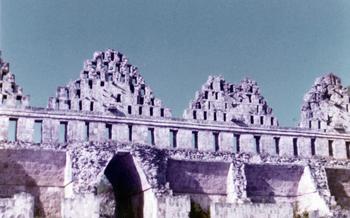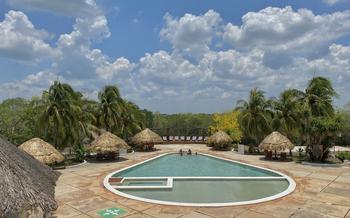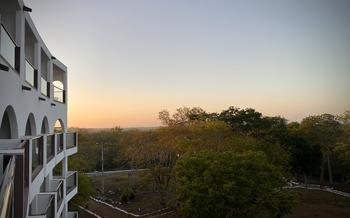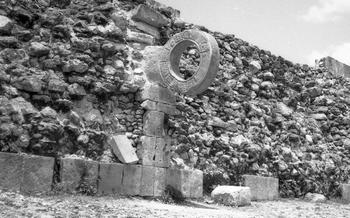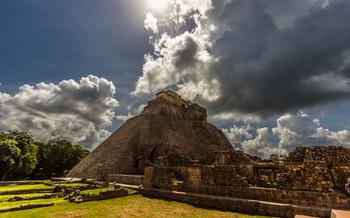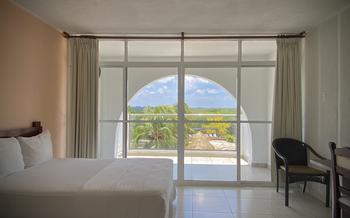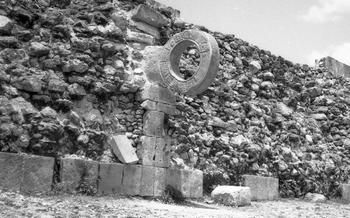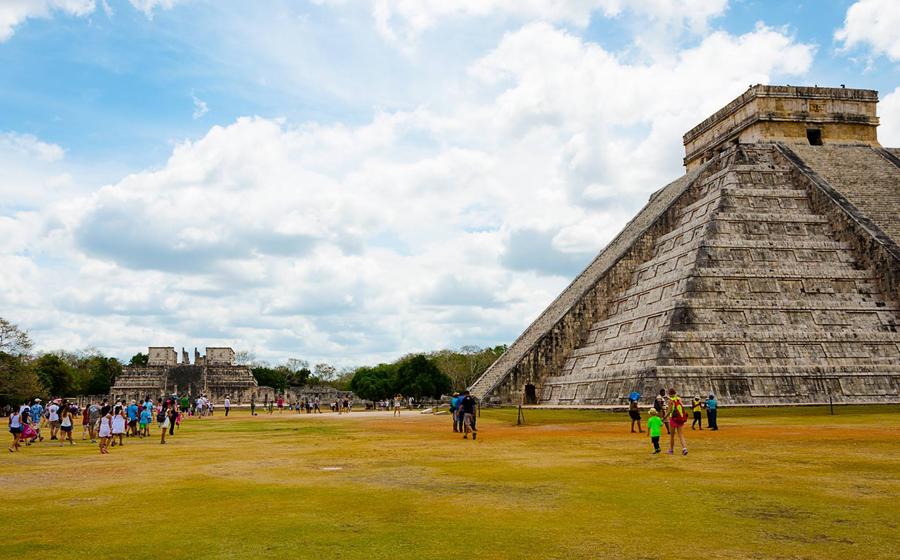
Chichen Itza
- Uxmal: A Majestic Mayan City in Mexico
- Exploring the Grand Plaza of Uxmal
- Unveiling the Pyramid of the Magician
- Discovering the House of the Turtles
- Exploring the Nunnery Quadrangle
- Unveiling the Ballcourt of Uxmal
- Discovering the Red House
- Admiration the Great Pyramid of Uxmal
- Exploring the Temple of the Old Woman
- Discovering the Quadrangle of the Birds
- Admiration the Temple of the Masks
- Exploring the Temple of the Turtles
Uxmal: A Majestic Mayan City in Mexico
Uxmal, a breathtaking Mayan city nestled in the heart of Mexico's Yucatán Peninsula, stands as a testament to the architectural prowess and cultural significance of this ancient civilization. Founded around the 7th century AD, Uxmal flourished as a major political and economic center, reaching its peak during the Late Classic period (600-900 AD). The city's well-preserved ruins, adorned with intricate carvings and towering pyramids, offer a glimpse into the lives and beliefs of the Maya people who once called this place home.
As you wander through the archaeological site, you'll be struck by the unique architectural style that distinguishes Uxmal from other Mayan cities. The city's buildings showcase a combination of Puuc and Chenes styles, characterized by corbelled arches, elaborate facades, and intricate geometric designs. These architectural elements, coupled with the city's strategic location on a hilltop, create a visually stunning landscape that has captivated visitors for centuries.
Uxmal is easily accessible from the nearby city of Mérida, making it a popular destination for travelers exploring the Yucatán Peninsula. Guided tours are available to provide insights into the history and significance of the city's landmarks, or you can choose to explore the site at your own pace, immersing yourself in the grandeur of this ancient Mayan wonder.
Exploring the Grand Plaza of Uxmal
The heart of Uxmal, the Grand Plaza, is an awe-inspiring sight that showcases the architectural prowess of the ancient Mayans. This vast open space is surrounded by some of the city's most significant structures, each adorned with intricate carvings and symbolic motifs that tell the story of Uxmal's rich history.
One of the most prominent structures is the Governor's Palace, a majestic edifice that served as the residence of the city's rulers. Its elaborate facade features a series of masks, geometric designs, and Chaac masks, paying homage to the Mayan rain god. Inside, visitors can explore a labyrinth of rooms and courtyards, each with its own unique architectural elements.
Equally impressive is the Nunnery Quadrangle, a complex of buildings that once housed religious and ceremonial activities. Its name is a misnomer, as it was likely used by male priests rather than nuns. The quadrangle is renowned for its beautifully preserved frescoes, which depict scenes from Mayan mythology and everyday life.
As you wander through the Grand Plaza, take time to admire the intricate carvings that adorn every surface. The Mayans were master storytellers, and their artistry is evident in the countless bas-reliefs, friezes, and stelae that embellish the plaza. These carvings depict everything from historical events and mythological scenes to everyday objects and animals, providing a glimpse into the lives and beliefs of the ancient Maya.
To fully appreciate the grandeur of the Grand Plaza, consider hiring a guide who can explain the significance of the various structures and their intricate symbolism. This will enhance your understanding of Uxmal's history and culture, making your visit even more rewarding.
Unveiling the Pyramid of the Magician
The Pyramid of the Magician, also known as the Great Pyramid, is one of the most iconic structures in Uxmal. Towering over the city at a height of 35 meters, this impressive pyramid is a testament to the engineering prowess of the ancient Maya. Its construction is believed to have taken place around the 6th century AD, during the height of Uxmal's power.
The pyramid's unique shape and architecture set it apart from other Mayan pyramids. It features a rounded base and five levels, each marked by a setback. The sides of the pyramid are adorned with intricate carvings, including representations of Chaac, the Mayan rain god, and other deities. These carvings provide valuable insights into the religious beliefs and practices of the ancient Maya.
Legends and theories abound regarding the construction and significance of the Pyramid of the Magician. One popular legend tells of a dwarf magician who, with the help of his supernatural powers, built the pyramid in a single night. Another theory suggests that the pyramid was built as a tomb for a powerful ruler or priest.
Climbing the steep steps of the Pyramid of the Magician is a must-do experience for visitors to Uxmal. The ascent offers breathtaking views of the surrounding landscape, including the lush jungle and the other ruins of the city. At the top of the pyramid, visitors can admire the intricate carvings up close and marvel at the skill and artistry of the ancient Maya builders.
Discovering the House of the Turtles
The House of the Turtles, also known as the Casa de las Tortugas in Spanish, is a remarkable structure located within the ancient city of Uxmal. Its most distinctive feature is the intricate carvings that adorn its facade, depicting a series of turtles arranged in a grid-like pattern. These carvings are believed to have symbolic significance, possibly representing fertility, protection, or the connection between the earth and the sky.
The House of the Turtles was likely a residential building, possibly occupied by a high-ranking Mayan official or a member of the royal family. Its elaborate carvings and impressive size suggest that it was a significant structure within the city. The carvings on the facade are particularly noteworthy for their detail and precision, showcasing the skill and artistry of the Mayan craftsmen who created them.
In addition to its intricate carvings, the House of the Turtles is also known for its unique architectural features. Its facade is adorned with a series of false doors, which are purely decorative and do not lead to any interior spaces. These false doors are believed to have had a symbolic or religious significance, possibly representing the entrance to the underworld or the realm of the gods.
Overall, the House of the Turtles is a fascinating and well-preserved example of Mayan architecture and artistry. Its intricate carvings, symbolic imagery, and unique architectural features make it a must-see for anyone visiting the ancient city of Uxmal.
Exploring the Nunnery Quadrangle
The Nunnery Quadrangle, also known as the Casa de las Monjas, is a captivating complex within the ancient city of Uxmal. This remarkable structure holds immense historical and religious significance, serving as a ceremonial and ritualistic center during the Mayan civilization.
As you enter the quadrangle, you'll be struck by its majestic architecture. The complex consists of four long, low buildings arranged around a central courtyard. The facades are adorned with intricate carvings, depicting various religious symbols and scenes from Mayan mythology. These carvings offer a glimpse into the spiritual beliefs and practices of the ancient Maya.
One of the most striking features of the Nunnery Quadrangle is its central pyramid, known as the Pyramid of the Birds. This pyramid is believed to have been used for religious rituals and ceremonies. Its name derives from the numerous bird carvings that adorn its facade, representing deities and messengers of the gods.
The Nunnery Quadrangle also houses a series of smaller temples and shrines, each with its own unique architectural features and symbolism. These structures were likely used for various religious ceremonies and rituals, including offerings, prayers, and divinations.
Exploring the Nunnery Quadrangle is a journey through time, allowing you to connect with the spiritual essence of the ancient Maya. As you wander through its corridors and courtyards, you can almost feel the presence of the ancient priests and priestesses who once performed sacred rituals within these walls.
Unveiling the Ballcourt of Uxmal
History and Significance
Immerse yourself in the history of the ancient Mesoamerican ball game as you explore the well-preserved ballcourt of Uxmal. This fascinating structure, dating back to the Classic period (600-900 AD), served as a venue for a ritualistic game that held deep cultural and religious significance for the Maya.
Architectural Features and Symbolism
Admire the unique architectural features of the ballcourt, including its sloping sides and carved markers. These elements not only contributed to the game's dynamics but also held symbolic meanings. The sloping sides, for instance, represented the Maya's belief in the cyclical nature of life and the underworld.
Theories and Rituals
Unravel the theories surrounding the rules and rituals of the ball game. While the exact rules remain a mystery, it is believed that the game involved two teams competing to hit a rubber ball through a stone hoop attached to the wall. The outcome of the game was often seen as a predictor of agricultural success or political events.
Tips for Capturing the Moment
To capture the essence of the ballcourt, position yourself at an angle that allows you to showcase its sloping sides and carved markers. Experiment with different lighting conditions, as the early morning or late afternoon light can create dramatic shadows that enhance the court's visual appeal.
Discovering the Red House
The Red House, also known as the House of the Governor, is one of the most prominent structures in Uxmal. Its name derives from the vibrant red paint that once covered its facade, although only traces of this color remain today. The Red House is believed to have served as a royal residence or temple, and its intricate carvings and elaborate architecture hint at the power and prestige of its former occupants.
The facade of the Red House is adorned with a series of intricate carvings, including geometric patterns, human figures, and mythical creatures. These carvings are believed to have symbolic and religious significance, and they offer a glimpse into the beliefs and practices of the ancient Maya. The interior of the Red House is equally impressive, with a series of interconnected rooms and chambers that were once used for various purposes.
Visitors to Uxmal can explore the interior of the Red House and admire its well-preserved architecture. The rooms are spacious and well-lit, and they offer a glimpse into the daily life and activities of the Mayan elite who once resided here. The Red House is a must-see for anyone interested in Mayan history and culture, and it is a testament to the architectural prowess of this ancient civilization.
Admiration the Great Pyramid of Uxmal
As you approach the Great Pyramid, the sheer size and majesty of this architectural marvel will leave you in awe. This colossal structure stands as a testament to the ingenuity and skill of the ancient Maya builders. With a height of over 115 feet and a massive base covering several acres, the Great Pyramid dominates the skyline of Uxmal.
The pyramid's exterior is adorned with intricate carvings and bas-reliefs, depicting scenes from Mayan mythology and everyday life. These carvings provide valuable insights into the culture and beliefs of the Maya people. The pyramid's imposing facade features a series of steep steps leading to a small temple at the summit.
Climbing to the top of the Great Pyramid is a must-do experience in Uxmal. The panoramic views from the summit are simply breathtaking. You'll be rewarded with stunning vistas of the surrounding jungle, dotted with ancient ruins and verdant vegetation. The climb is challenging but manageable, and the rewards are well worth the effort.
As you stand atop the Great Pyramid, take a moment to reflect on the incredible achievements of the ancient Maya. This awe-inspiring structure is a symbol of their architectural prowess and a reminder of the rich cultural legacy they have left behind.
Exploring the Temple of the Old Woman
Deep within the ancient city of Uxmal lies the enigmatic Temple of the Old Woman, a testament to the spiritual beliefs and architectural prowess of the Maya civilization. This sacred edifice holds a significant place in the history of Uxmal, serving as a religious and ceremonial center for the Maya people. Its unique shape and carved figures set it apart from other structures in the city, inviting visitors to unravel its mysteries and delve into its captivating past.
The Temple of the Old Woman is a multi-chambered structure, featuring a series of interconnected rooms and chambers that were likely used for various religious rituals and ceremonies. The exterior of the temple is adorned with intricate carvings depicting various deities, mythical creatures, and scenes from Maya mythology. These carvings provide valuable insights into the beliefs and practices of the Maya people, offering a glimpse into their spiritual world and the significance they placed on religious ceremonies.
One of the most striking features of the Temple of the Old Woman is its unique shape. Unlike many other temples in Uxmal, which are typically pyramid-shaped, the Temple of the Old Woman has a more elongated and rectangular form. This unique design may have been influenced by the specific rituals and ceremonies that were performed within the temple, requiring a different architectural layout to accommodate the specific needs of these religious practices.
The Temple of the Old Woman is a testament to the architectural prowess of the Maya civilization. Its intricate carvings, unique shape, and historical significance make it a must-visit destination for anyone interested in exploring the rich cultural heritage of the Maya people. As you wander through the temple's chambers and admire the intricate carvings, you can almost feel the presence of the ancient Maya, connecting you to a world that existed centuries ago.
Discovering the Quadrangle of the Birds
The Quadrangle of the Birds, also known as the House of the Pigeons, is a remarkable complex located on the southern side of the Grand Plaza in Uxmal. Its name derives from the intricate carvings of birds, particularly doves, that adorn the facades of its buildings. The quadrangle served as a residential or administrative complex during the city's heyday.
The Quadrangle of the Birds consists of four long, low structures arranged around a central courtyard. The buildings feature thick walls, narrow doorways, and corbelled vaults, which were a common construction technique in Mayan architecture. The facades are adorned with elaborate carvings, including representations of birds, geometric patterns, and human figures.
The most notable carvings in the Quadrangle of the Birds are the depictions of birds, which are believed to represent doves or pigeons. These birds were considered sacred in Mayan culture and were associated with fertility, peace, and renewal. The carvings showcase the remarkable skill and artistry of the Mayan craftsmen who created them.
Exploring the Quadrangle of the Birds offers a glimpse into the daily life and activities of the Mayan people who lived in Uxmal. It is a fascinating place to wander around, admire the intricate carvings, and imagine the hustle and bustle of the city in its prime.
Admiration the Temple of the Masks
The Temple of the Masks, also known as the House of the Masks, is a remarkable structure located within the archaeological site of Uxmal. Its historical significance lies in its role as a religious and ceremonial center, where ancient Mayan rituals and ceremonies took place.
The temple's architectural features are particularly striking. Its facade is adorned with intricate carvings depicting a series of grotesque masks, each with unique expressions and features. These masks are believed to represent various deities or supernatural beings, and their presence suggests the temple's importance in religious practices.
As you explore the temple, pay attention to the elaborate details on the masks. Each mask has its own distinct character, and some even appear to be smiling or grimacing. The intricate carvings showcased the skill and artistry of the Mayan craftsmen who created this masterpiece.
The Temple of the Masks is not only a testament to the Mayan's architectural prowess but also provides valuable insights into their religious beliefs and practices. As you stand before this awe-inspiring structure, imagine the ancient Mayans performing sacred rituals and ceremonies within its walls and feel a connection to the rich history and culture of this ancient civilization.
Exploring the Temple of the Turtles
The Temple of the Turtles, a captivating architectural wonder in the heart of Uxmal, stands as a testament to the intricate artistry and spiritual beliefs of the ancient Maya civilization. Its name derives from the intricate carvings of turtles that adorn its facade, each believed to hold profound symbolic significance. The temple's history is shrouded in mystery, with theories suggesting it served as a religious center, a place for celestial observations, or possibly a combination of both.
As you approach the Temple of the Turtles, its imposing presence commands attention. The grand staircase leading to its summit invites you on a journey back in time, as you ascend towards the heavens, just as the ancient Maya priests once did. The temple's facade is adorned with intricate carvings, each telling a story of the Maya people, their beliefs, and their connection to the cosmos.
Inside the temple, a world of spirituality unfolds. The walls are adorned with vibrant murals depicting scenes from Maya mythology, offering a glimpse into their rich and complex belief system. Overhead, the ceiling is adorned with intricate stuccowork, creating a sense of awe and wonder. The temple's acoustics are said to be remarkable, enhancing the sense of spirituality and connection to the divine.
Visiting the Temple of the Turtles is an unforgettable experience, transporting you to a time when the Maya civilization thrived. Allow yourself to be immersed in the temple's sacred atmosphere, marvel at its architectural beauty, and contemplate the mysteries that it holds.
